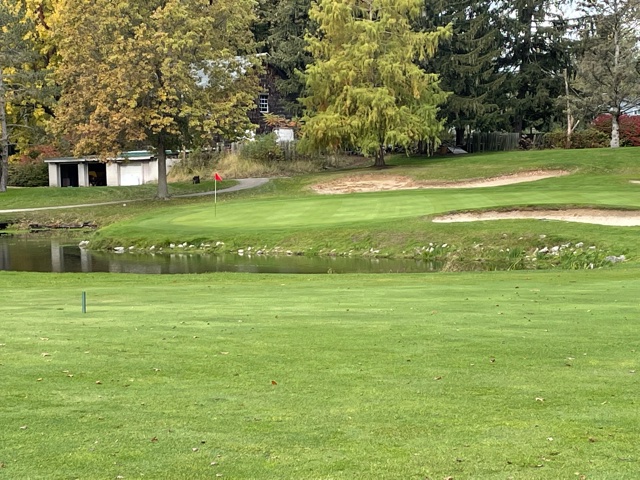If you watch any professional golf on the weekends, you will see many of the professionals hitting a fade, especially with the driver.
If you head to any local course and watch high handicap golfers play, you will see plenty of sliced shots, especially with the driver.
There is a definite difference between the fade and the slice. The fade is a quality shot to play, while the slice can be devastating due to the loss of control, distance and the overall spin rate.
Many of the greats such as Tiger Woods, Jack Nicklaus and Ben Hogan predominantly played a fade shot as there are some major advantages to the shot. Overall, as long as you have a consistent start line with the consistent shot shape you can play high level golf.
This post dives into the fade shot in golf and dives into the following:
- What is a fade shot
- The ball flight laws related to a fade shot in golf
- How to hit a fade shot
- Why one might hit a fade shot
- When to hit a fade shot
- How to develop a stock shot that is a fade
- 3 Fundamentals to take your game to the next level

1) What is a fade shot?
The fade shot for the right handed golfer will have a slight curve to the right. Some will start the ball left of the target line and hit a slight pull fade, while others will aim further left and hit a push fade. Both shots are highly effective in controlling the curve and providing a high level of accuracy and control over the golf ball.
The elite level golfer will often hit a slight push fade. I think of Jack Nicklaus and Lee Trevino. While Trevino aimed further left, they both hit the ball from the inside with a path and face relationship that produced a push fade.
Most amateurs will more than likely hit a pull fade and can play it with a high level of success. As long as the pull fade doesn’t turn into a pull slice, the golfer can have a high level of success.
How to hit a fade shot with a driver
2) The ball flight laws related to a fade shot in golf
Understanding the ball flight laws is important to help you understand what actually causes the fade shot in golf. For many years, golf instructors believed that the swing path had the greatest impact on the start line, but the new technology has shown us that the ball will start relative to the clubface at impact.
As a result, the push fade is hit with a club face that is open to the target line, and also opened to the path.
The basic idea of the ball flight is that the ball will start in the direction that the club face is pointing at impact. The clubface controls about 75% of where the ball will start.
From there it will curve based on the swing path relative to the club face.
For example, if your club face is 2 degrees right and your path is 2 degrees left. The ball will start right and curve right towards the target, which is away from the swing path direction.
To develop a consistent shape in your shot pattern, you will attempt to build similar numbers with the majority of your golf swings.
Below, I will provide several examples that help you practice what way your ball will curve and get the general understanding of what is taking place. The goal is to eliminate the shot that starts and curves in a different direction then what you are intending to do.
This will help eliminate big numbers from your scorecard.
Having this information will help you make the adjustments mid round or post round and not get stuck in the rabbit hole of swing corrections.
I provide three examples below, all which include a club face that is right and a path that is right. You can see how a slight variation in the difference between the face and the path can cause a ball to curve.
Ball Flight Laws: Scenario 1
Clubface: 3 degrees right
Swing Path: 3 degree right
The ball will start right of the target line (club face is 3 degree open or right) and fly straight since the clubface and the swing path are the same number of degrees open or right of the target line.
The end result is a push shot. The ball will start right and stay right.
Ball Flight Laws: Scenario 2
Clubface: 3 degrees right
Swing Path: 5 degree right
The ball will start right of the target line (club face is 3 degree open or right) and curve away from the swing ptch, which means it will curve left.
The end result is a draw shot. The ball will curve a decent amount with these numbers.
This shot would be considered a push draw.
Ball Flight Laws: Scenario 3
Clubface: 3 degrees left
Swing Path: 10 degree left
The ball will start left of the target line (club face is 3 degree closed or open) and slice since there is a big gap between clubface and swing path. The end result is a pull slice. The ball will start left and curve hard to the right.
This is a shot that many amateurs struggle with. They continue to aim further and further left. The swing path keeps moving left and the face remains open. The end result is a full slice.
This last example is the opposite of an inside out golf swing.

3) How to hit a fade shot
3 Tips Below
TIP #1: Aim Your Feet Line Left, but Keep Club Face Square
The number one easiest way to hit a fade is to aim your feet line to the left of the final destination of the ball, but keep your club face right down that target line. Next, swing along your feet line, creating a slight leftward path that has an open face.
Your golf ball will start slightly left of the target line and fade back towards the target. The open stance and square face at setup helps produce ball flight numbers that produce a fade spin on the ball.
TIP #2: Aim Your Feet Line Left, but Swing Down the Target Line
If you aim far enough left, you can hit the shot that is more of a push fade. The golfer will want to aim their stance line left, but stay through the shot and keep the path slightly in to out. The key is to keep the club face right of the swing path.
This takes some time to lock in and get your aiming points just right to be able to hit this shot. The best example and the person to check out on this shot is Lee Trevino. He was often aimed well left of the final destination of the ball and hit a push fade that split fairways in half!
TIP 3: Hold Off Your Release
The third option or tip is to set up just slightly left of the target line and aim your club face along your stance line. Play with a slightly weaker grip and hold off the release, your body and arm action can still be aggressive; you just ensure your club face stays to the right of the swing path, producing a left to right spin. This shot is an excellent option when playing lower shots around trees from the rough or if you are used to hitting a draw and get nervous about the double cross shot in golf.
4) Why one might hit a fade shot
There are some major advantages of the fade. They include:
- Easier to control with the driver.
- Lands soft with the irons.
- The pull fade is a powerful swing that is repeatable.
Many professional golfers that first appear on tour that hit a draw with the driver and possess plenty of club head speed, will sometimes learn to hit the fade with the driver. Brooks Koepka, Dustin Johnson and Tiger Woods often play their best golfer when they are hitting the power fade.
The fade with the driver allows the golfer to go at the ball pretty hard and rely on that gentle fade that falls back towards the middle of the fairway. Many US Opens have been won in recent history by the person that can hit the power fade with the driver, which allows them to maintain plenty of distance, but still remain somewhat accurate.
Some of the best iron players of all time, especially with the long irons, are those that play the slight fade with the irons. This is the shot that flies plenty high and then lands softly on the greens. One of the best fade golfers of all time is Lee Trevino who had precision with every club in the bag by hitting a slight push fade time and time again.

5) When to hit a fade shot
There are some key times when a golfer will want to hit a fade shot. These include the following:
- The pin is on the right side of the green
- The fairway curves from left to right
- The player wants greater control with the driver
When the pin is on the right side of the green, the golfer that is able to aim at the middle of the green and hit a fade will have the best chance of hitting one close. If the ball happens to fly straight, no big deal, you’ve hit the middle of the green and might have a 30 foot putt.
However, when the pin is tucked left and you have to aim outside of the green, this is when trouble might creep in, if you were to hit a straight shot by accident.
Also, when a fairway curves from left to right, it helps maximize the distance you have and it helps keep the ball in play. For those that fade the ball, they will often prefer this shaped hole and the opposite is true for the golfer that hits a draw consistently.
And as we talked about earlier, many professionals turn to the power fade with the driver because they are able to eliminate the hook and it provides great control with the driver.
When to hit a fade in golf (complete post)
6) How to develop a stock shot that is a fade
The ability to start your ball down the intended start line and have it curve in a predictable direction is paramount to your overall success as a golfer and hitting more fairways. If you watch the best golfers you can find at your home golf course, they will often have a predictable shot pattern with a smaller dispersion than the worst golfers.
Whether you play a stock draw or a stock fade, the key is to have your golf ball consistently curve in the same direction. You do not need to work the ball both ways, if you can control the curve of your golf ball.
Practice this drill and then complete an assessment at least once a week and chart your progress. Understanding the ball flight laws will help you develop this shot.
If you want to hit a draw, make sure you setup the drill to learn to hit a stock draw.
Complete Post: Ball Flight Laws Explained
The Stock Shot Drill
- Set up an alignment stick about 6-8 yards in front of you, straight down your target line.
- If you have a second alignment stick, set the stick 2-3 feet right of the first stick (for a draw) or left of the first stick (for a fade).
- Complete your initial assessment see how many times out of 10 you can start the ball to the right or left of your target. Pick one side and measure your game at this point.
- The goal is to eventually get 7 out of 10 shots to start to the correct side and draw back towards the target.

7) 3 Fundamentals to take your game to the next level
If you want to take your game to the next level, we must get good at the three fundamentals below. No, we don’t get into the grip, or ball position or grip tension, etc. The three fundamentals are all swing produced results.
The Stack and Tilt Instructors said it best when they described what they believed were the fundamentals of golf. They explained it somewhat similar to this:
- The first fundamental is the golfer’s ability to control the bottom of the golf swing. The best golfers will hit the ground in the intended spot, close to 100% of the time.
- The second fundamental is the golfer’s ability to control the curve of the golf ball. The best golfers are able to start the ball to the right or left of the target line and have the ball curve towards the target without the ball over-curving past the target.
- The third fundamental is the golfer’s ability to have enough power to play the golf course. This means they are able to hit the ball far enough to play the course in regulation.
They promoted a draw, I would promote whatever you can hit consistently. If the fade is the best shot for your game, go ahead and play it and count on it!
Final Thoughts: Study Your Swing and Then Own Your Swing
When you hit a bad shot, make sure you watch the entire flight and know what the ball actually does. Too many golfers turn in frustration instead of connecting the feel or the swing with the result. If you hit a pull hook, did you feel your hands and your body come through too much?
Now that you understand the ball flight laws and the keys to hitting a fade, oftentimes your best teacher is your ball flight. You know the adjustments to make, keep your adjustments simple and hit your shot!
One thing that has helped me greatly is my SkyTrak Launch Monitor.
It provides instant feedback on club speed, club face, spin axis and spin loft. When playing in my golf simulator in my garage, I am able to work on my start line and club head control. This helps me make adjustments when I actually play on a course.
The simulator golf has helped me reduce 4-6 shots by working mainly on tips #1 and #2. The game of golf doesn’t have to be complicated, work to keep it simple and to read your ball flight!
Many of our worst shots are caused by our fears of certain misses and we get in our own way.
The great news is that a place like Rain or Shine golf has great deals and offers financing. Check them out below:
Take Action – What You Can Do Today to Get Better
What does this mean for you? I believe in the following recipe to get better:
1 – Improve your motion in the golf swing by identifying a golf instructor. Here are some options:
Here is a list of golf instructors that we have reviewed:
2 – Train to swing faster and improve your swing speed. Here are some options:
Looking to gain more Speed and Distance in your swing. Two Options:
3 – Understand course strategy and work to break through your next barrier. Here is a series on breaking through:
We have provided guides on how to break 100, 90, 80 and 70. Check out more below, if interested.
4 – Practice Frequently
Did you know that I build a golf simulator in my garage and have played over 500 rounds of golf on my SkyTrak system? It has been a game changer and one worth checking out. Here are some of my other posts on golf simulators frequently asked questions:
- Is a Golf Simulator Worth It?
- How to Build a Golf Simulator?
- What is the Best Golf Simulator?
- Golf Simulator Accessories?
- How to Build a Golf Simulator for under $7000
- Top 11 Reasons to Buy a SkyTrak
- How to Build a Golf Simulator for Under $1000
- Why Build A Golf Simulator?
- What Space is Needed?
- Can A Golf Simulator Improve My Game?
- How Much Does A Golf Simulator Cost?
- Don’t Forget to Check out our 15 best golf swings of all time.
I am an amateur golfer on a journey to get better, enjoy the game as often as possible and share my passion and knowledge with others. I have coached high school golfers at a high level and have a great passion for the game and want to give back. I enjoy learning about the golf swing and am currently studying to be a certified professional golf instructor. Join me in our journey to get better everyday. Thank you for reading!

